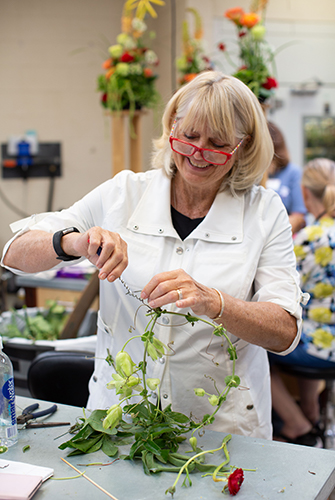Floral Fundamentals
The mechanics Ring references are largely the result of Benz’s groundbreaking influence on the floral industry. He was the first person to base floral design on theory and principles of design. After graduating from Texas A&M and serving in the military, he opened the Benz School of Floral Design in Houston in 1946. He became known for his innovative style and exciting design forms, and as his reputation grew, so too did his travels and exposure to different cultures. Soon he found himself teaching and writing about his theories of design in a series of four books that remain central to the field today.
“Buddy Benz was first and foremost open to all expressions of art, architecture, philosophical thought and social change,” said Jim Johnson ’78, who met Benz while attending his classes in 1958. “He was a lover of nature and used all these things to form his theories of floral design.”
 Students learn about topics including the care and handling of cut flowers; wiring and taping; principles and elements of design; and flower shop management.
Students learn about topics including the care and handling of cut flowers; wiring and taping; principles and elements of design; and flower shop management.
As he neared retirement, Benz decided to establish a unique legacy at Texas A&M through a gift from his estate. First, he created the permanent Benz School within the university’s horticulture department. He also donated his entire library of floral design books and his collection of fine art, acquired through his many travels. This includes some 1,200 art pieces, sculptures, ceramic vessels and accessories used in his floral designs, as well as some 75 works of pictorial art from the Renaissance to the Modernist Periods. Pieces of his collection are on rotating display in the Benz Gallery of Floral Art housed in the atrium of the Horticulture/Forest Science Building at Texas A&M.
The third portion of his gift established the world’s only chair in floral design. Funds from the chair first supported Johnson, who Benz personally asked to serve as the school’s first director, and now support the work and teaching activities of McKinley. The school is an asset not only for the endowed chair and all the associated floral artifacts, but also for the teaching opportunities it creates,” said McKinley. “Both Benz School students and Texas A&M horticulture students gain experience via the many designs the school undertakes throughout the year for campus events. The Benz School has also fostered my growth as a floral artist by expanding opportunities for me to present to garden clubs and professional organizations and collaborate with floral artists worldwide.”
Today, the Benz School has expanded to include a teaching program in South Korea, after a group of Korean floral design teachers approached Johnson in 2005 asking for the Benz material to be taught in their country. “By 2007, we translated the material and invited 20 teachers to campus for a three-week total immersion session to learn our teaching methods,” said Johnson, who now serves as emeritus director of the Benz School. Today, there are approximately 40 active instructors teaching Benz School methods in Korean private schools, colleges and universities. McKinley travels to Seoul twice per year to evaluate the students of these teachers and to award Benz School certificates.
He’s excited that more and more people are learning the Benz School ways and discovering that floral design is something much deeper than meets the eye—a refined craft guided by balance, proportion, harmony and contrast. Johnson, who became hooked on floristry by age 15, is equally enthused. “Benz’s greatest influence on me was the idea that floral design can be an art form, not just a ‘paint by numbers’ exercise,” he said. “It can be something altogether exquisite.
Start Your Bequest Today
Creating a bequest is one of the easiest ways to establish a planned gift through the Texas A&M Foundation, and bequests generate millions of dollars for Texas A&M each year. After adding the Foundation’s bequest language to your will or trust, you can specify that a gift be made to support Texas A&M students, faculty, colleges, programs or student organizations. You can gift a percentage of your estate, a specific amount or the balance of your estate. Benefits include the ability to retain assets during your lifetime, lessen the burden of estate taxes on your family, and establish a Texas A&M legacy. You can view our bequest language here. If you have already made a bequest for Texas A&M in your will or trust but haven't notified the Foundation, please let us know by emailing info@txamfoundation.com or calling (800) 392-3310.